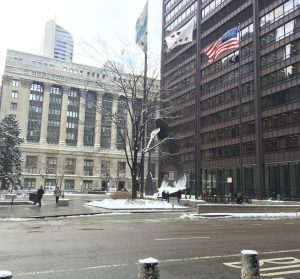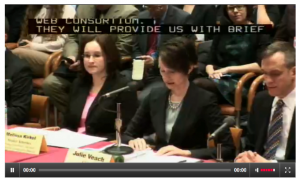by Bryce Wolf
June 23, 2008 – Most of the nearly 100 people who met recently to discuss a plan by Friends of the Parks to extend a miles-long lake front path through Edgewater and Rogers Park met with resistance from many in the room. The residents said they wanted their beaches left alone; no landfills, no bike trails, no development.
“This is a conversation we as a community need to have,” said Katy Hogan , owner of the Heartland Café .
Despite the community’s resistance, the non-profit organization Friends of the Parks still wants to extend the lake front path, solving what the group calls a lack of accessible public space on the north shore. Pro-bono architects Greene and Proppe and students from Loyola have illustrated designs of the paths, which would run between Hollywood and Devon avenues in Edgewater and Devon Avenue and Juneway Terrace in Roger’s Park.
While many residents agreed the lake front could be improved, they opposed new construction. They fear housing values will drop and crime rates will increase. They also voiced concerns there won’t be room for emergency vehicles to aid anyone injured on the walking path.
“We want to see money going toward beach improvements,” said Michael Harrington, a Rogers Park resident who regularly takes his children to Jarvis Beach. “I see people from Logan Square, the suburbs and all over Chicago coming here to enjoy our beaches just the way they are.”
One resident said she would like to see a bike trail along the lake front because Roger’s Park is “the least bike-friendly neighborhood.” She said if a trail isn’t created, Sheridan Road must be made safer for bicyclists because the main streets are dangerous, the side streets are confusing, and bikers can be fined for riding on sidewalks.
Philip Bernstein, who runs the Web site Stop the Landfill , argues the economic and environmental costs of such a project would be too great.
“The Friends of the Parks cannot answer any of the following questions,” said Bernstein. “What will it cost? How long will it take to build? Where will the money come from? How many other projects programmed for the existing parks will be sacrificed because money will have to be reallocated to this project?”
The organization says it cannot provide estimates on the costs or a timeline because proponents are only in the concept stage and have no concrete plans.
Eleanor Roemer, policy director for Friends of the Parks, agrees minimal construction is best but reiterated the organization would like to see the lake front enhanced with wider paths and a continuous trail from the north to the south shore.
Stop the Landfill counters the Friends of the Parks’ assertion that existing parks are inaccessible and crowded. Bernstein says the majority of beaches are within one block of each other and rarely filled to capacity.
Loyola University which owns the land from North Shore Avenue to Devon and into Lake Michigan itself, has an uninterrupted walkway along the lake front open to the public.
Loyola’s director of public relations, Jennifer Clark, says the university is not pushing for development along the lake front but would not be opposed if it can be carried out in an environmentally friendly and economically feasible way, with full community support.
A few decades ago, a different administration at the university suggested a landfill in the lake, but school officials determined the environmental damage to the shoreline wasn’t worth the cost of the added parkland, Clark said.
Mike Krasowski, a geologist with the U.S. Geological Survey, said the submitted designs have been vetted to determine if they violate coastal standards, and they do not. Building strong, low sea walls along the beaches would also prevent erosion, he said, and reduce the risk of flooding if Lake Michigan’s water level rises.

![Reblog this post [with Zemanta]](http://img.zemanta.com/reblog_e.png?x-id=cd03e894-0c35-4dce-854d-1e1fa9beee13)





Be First to Comment